Beezone Preface
This edition of Sir Frederic G. Kenyon’s Ancient Books and Modern Discoveries is presented with the permission of time itself. The original text, first published in 1927, belongs to an earlier era of scholarship, when archaeology and philology were advancing rapidly but had not yet been illuminated by the many discoveries of the last century. Kenyon’s voice speaks with the confidence of a man who stood at the threshold of those discoveries and sought to make sense of them for his own age.
What you hold here is not only a historical document, but also a personal one. To prepare this annotated version, I made my own pilgrimage into the archives—consulting the rare book room of Harvard’s Houghton Library, where Kenyon’s slim volume is preserved. The book itself is a treasure: richly adorned with colorful calligraphy, handsomely bound, and printed on thick, delicate paper that testifies to the craft of an earlier publishing world. It is, in every sense, a rare and fragile object, one that must be handled with care, even reverence.
The Beezone has always sought to keep alive the thread of wisdom, to uncover how the past speaks into the present. Kenyon’s work is an ideal companion in this effort. It is a record of scholarship before the full flowering of modern archaeology, and yet it remains credible, accessible, and illuminating. By providing annotations and updates alongside his text, we mean not to correct or diminish his contribution, but to honor it—showing how his insights remain foundational, even as new discoveries extend the horizon of human knowledge.
Editor’s Note:
The following chapter preserves Kenyon’s original text as first published in 1927. Modern annotations, inserted in brackets, highlight discoveries and refinements made since his time. These notes are intended to supplement at the bottom, not replace, Kenyon’s scholarship—allowing his work to be read both as a classic statement of early 20th-century knowledge and as a foundation enriched by later research.
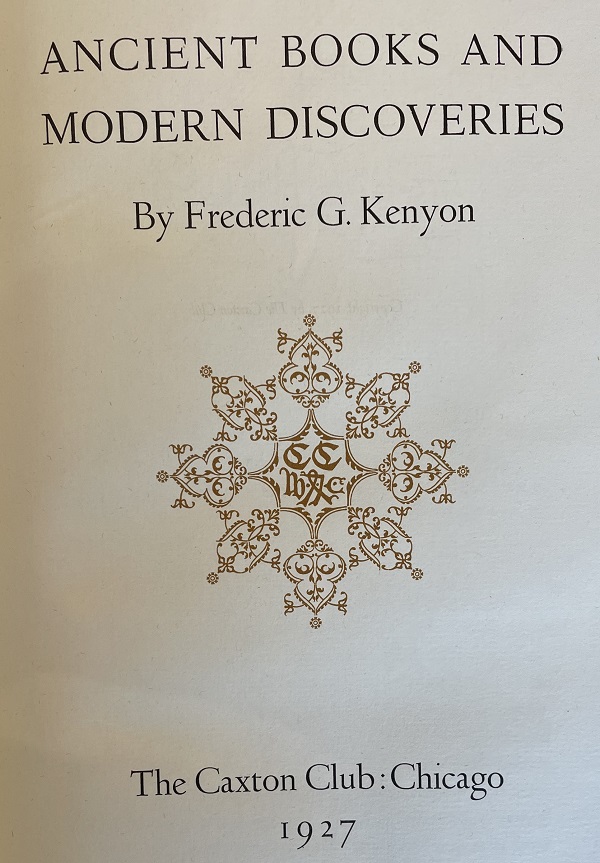
Sir Frederic George Kenyon (1863-1952) GBE KCB TD FBA FSA was a Greek and biblical scholar and museum director. He was the Commission’s honorary artistic advisor from 1917 until 1948; a role he fulfilled alongside his position as Director of the British Museum.
Frederic George Kenyon was born on 15 January 1863. He was educated at Winchester and New College, Oxford. In 1903, he was elected a Fellow of the British Academy and was later their President from 1917 to 1921. He was appointed the Director and Principal Librarian of the British Museum in 1909 and President of the Classical Association in 1913. He held the office of Gentleman Usher of the Purple Rod of the British Empire from 1918 to 1952. Kenyon was a Fellow of Winchester College and an Hon. Fellow of Magdalen and New Colleges, Oxford.

CHAPTER I.
The Antiquity of Writing
The purpose of this essay is to give some picture, according to our present knowledge, of the various methods by which man has endeavored to commit his words,—the repositories of his experience or his thoughts—to permanent record by some form of writing. The perpetuation of the spoken word in enduring form is one of the most potent elements of civilisation; and the manner in which it has taken place in different times and in different countries has fundamentally affected the course of the intellectual development of nations. The inquiry is not, therefore, a mere matter of antiquarian interest. The literary history of a country is only intelligible if the manner in which its literature was preserved is understood; and some literary problems of the highest importance, such as the origin of the books of our Bible, or, in secular literature, of the Homeric poems, which are the fountain head of Greek, and therefore of all modern, literature, need for their interpretation some acquaintance with this material question.
The present summary does not pretend to be exhaustive, in the sense of covering all countries and all periods. My

knowledge is not sufficient for such a survey, and it would include much matter which is of a very limited interest and has no bearing on the main course of our Western culture. But it deals with all the main channels from which that culture has been derived,—channels which have their origin in the valleys of the Tigris and the Nile, and which, through the great main streams of Hebrew, Greek and Roman literature, are the fountain heads of our intellectual life today.
Our knowledge of ancient literature has been profoundly affected by the discoveries which have been made within the last two or three generations and are Still being made, year after year, today; so that our inquiry will have to deal incidentally‘with those discoveries of lost books which have been such an exciting feature in modern scholarship,—which have increased the store of knowledge placed at our disposal, and widened our conceptions of the workings of the human mind.
At the foundation of all our inquiry lies the question of the antiquity of writing. For this purpose the term “writing” must be used in its widest sense. It includes not merely the inscribing of words on paper in ink or pencil, as we use the term today, but any method by which continuous groups of words have been committed to permanent record, and by which men have aimed at preserving their thoughts, or statements of facts, or records of agreements. At what period in the history of civilisation was this enormously important new departure made?
Until quite recently it was usual to maintain that writing was a relatively late accomplishment. It was argued, and
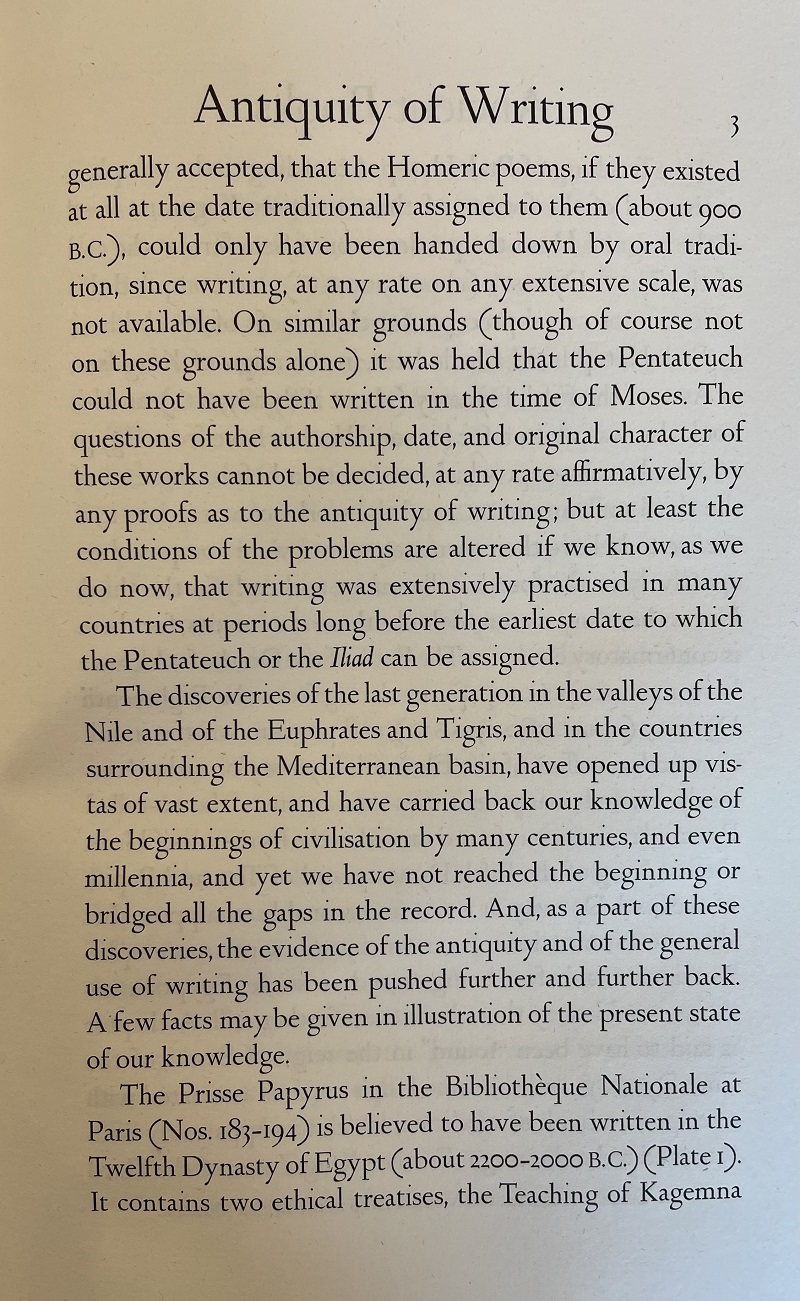
generally accepted, that the Homeric poems, if they existed at all at the date traditionally assigned to them (about 900 B.C.), could only have been handed down by oral tradition, since writing, at any rate on any extensive scale, was not available. On similar grounds (though of course not on these grounds alone) it was held that the Pentateuch could not have been written in the time of Moses. The questions of the authorship, date, and original character of these works cannot be decided, at any rate affirmatively, by any proofs as to the antiquity of writing; but at least the conditions of the problems are altered if we know, as we . do now, that writing was extensively practised in many countries at periods long before the earliest date to which the Pentateuch or the Iliad can be assigned.
The discoveries of the last generation in the valleys of the Nile and of the Euphrates and Tigris, and in the countries surrounding the Mediterranean basin, have opened up vistas of vast extent, and have carried back our knowledge of the beginnings of civilisation by many centuries, and even millennia, and yet we have not reached the beginning or bridged all the gaps in the record. And, as a part of these discoveries, the evidence of the antiquity and of the general use of writing has been pushed further and further back. A few facts may be given in illustration of the present state of our knowledge,
The Prisse Papyrus in the Bibliotheque Nationale at Paris (Nos. 183-194) is believed to have been written in the Twelfth Dynasty of Egypt (about 2200-2000 B.C.) (Plate 1). It contains two ethical treatises, the Teaching of Kagemna

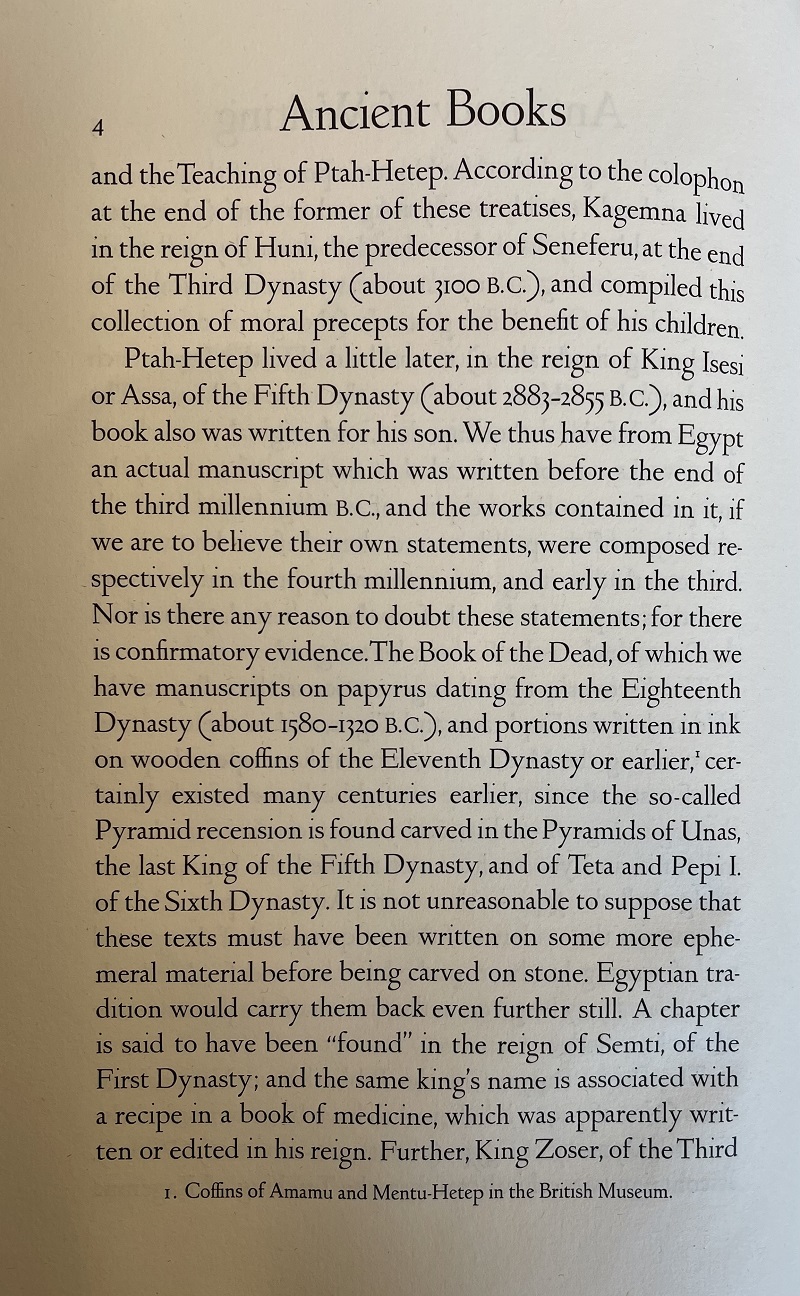
Dynasty, is said to have been a patron of literature, and portraits and tombs of persons described as “scribes” exist from the Fourth Dynasty. Certain chapters of the Book of the Dead are said to have been composed in the reign of Menkau-ra (Mycerinus ), the fifth king of that· Dynasty; and the medical prescriptions preserved in British Museum Papyrus 10059 are assigned to the Fifth Dynasty.
There is, therefore, a considerable body of testimony pointing to the free use of writing in Egypt in the earliest dynastic period, well before 3000 B.C., while actual manuscripts exist which there is good reason to place before 2000 B.C. From Babylonia evidence of an equally early date is even more conclusive, since actual specimens of this remote antiquity are plentiful. For these we were first indebted to the discoveries of de Sarzec at Telloh and the American excavators working at Nippur under the auspices of the University Museum of Philadelphia. The excavations of Layard and Rassam in 1852-53 had given us a whole library of Assyrian texts in cuneiform writing of the latter part of the eighth and the beginning of the seventh century B.C. In 1877 the discovery of a collection of cuneiform tablets at Tell-el-Amarna, in Egypt, not only carried back our evidences of cuneiform writing to about 1400 B.C., but proved that this writing was in common use in Syria for official correspondence between the governors of provinces and their overlord in Egypt. But the Nippur discoveries (in 1888-1900) pushed back the boundaries of our knowledge by at least another 1,000 years. In the archives of this town were found thousands of clay tablets dating back to about

2200 B.C., and stone inscriptions of about 2900 B.C. Many of these record business transactions and other ephemeral matters, but some of them, are literary, and all alike prove the existence and common use of writing at this remote period in the countries of Mesopotamia.
[Modern Note]: Now recognized that proto-cuneiform in Uruk (~3350–3000 BCE) predates these. Even earlier, Mesopotamian cylinder seals (~4400 BCE) are viewed as precursors, linking imagery to emerging script.At Telloh clay tablets were found as early as 2800 B.C. This evidence has been supplemented and extended during the last two or three years by the discoveries of the joint expedition of the British Museum and the University Museum of Philadelphia under Mr. Woolley at Ur of the Chaldees (Plate 2), while at Kish the Oxford and Chicago expedition under Professor Langdon found the most primitive writings of all, which can hardly be later than 3500 B.C.
In other countries our evidence does not reach such remote antiquity, but the discoveries of recent years have at any rate greatly increased our knowledge. At Boghaz-Keui, in Anatolia, German excavators before the war had discovered the archives of the Hittite Empire, containing Hittite dialects, of the second millennium B.C. In Crete the great discoveries of Sir Arthur Evans at Knossos included a large number of tablets, some in an earlier pictographic script and others in a linear script derived therefrom. These are still undeciphered, and their exact dates are undetermined, but at any rate they prove the existence of writing in various forms, which go back to about 2000 B.C.
For writings in the three languages which concern us most (since they underlie and form a main part of our own civilisation), Hebrew, Greek, and Latin, the evidence
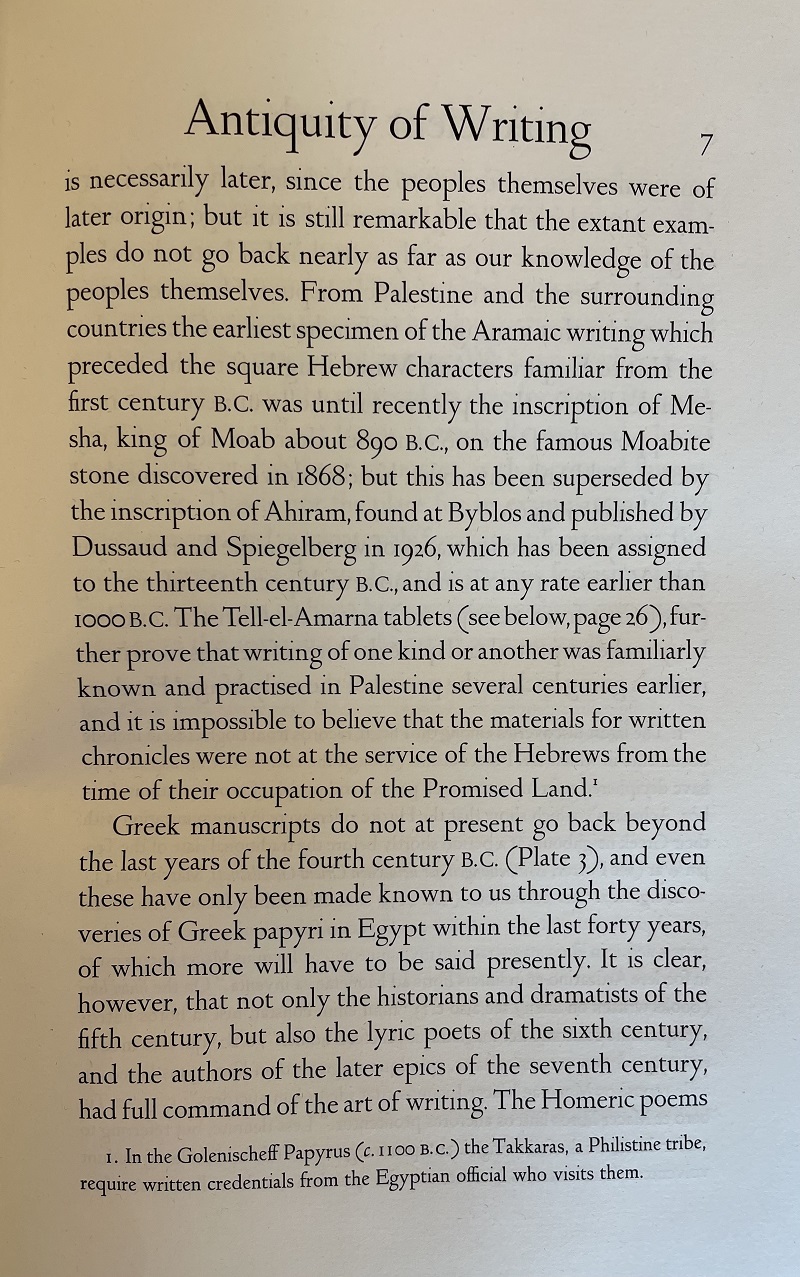
is necessarily later, since the peoples themselves were of later origin; but it is still remarkable that the extant examples do not go back nearly as far as our knowledge of the peoples themselves. From Palestine and the surrounding countries the earliest specimen of the Aramaic writing which preceded the square Hebrew characters familiar from the first century B.C. was until recently the inscription of Mesha, king of Moab about 890 B.C., on the famous Moabite stone discovered in 1868 ; but this has been superseded by the inscription of Ahiram, found at Byblos and published by Dussaud and Spiegelberg in 1926, which has been assigned to the thirteenth century B.C.,and is at any rate earlier than 1000 B.C.
[Modern Note]: Earlier evidence has since been found. The Wadi el-Hol inscriptions (~1900 BCE) and the Lachish comb (~1700 BCE) push the alphabet’s origins back by over seven centuries.
The Tell-el-Amarna tablets (see below, page 26), further prove that writing of one kind or another was familiarly known and practised in Palestine several centuries earlier, and it is impossible to believe that the materials for written chronicles were not at the service of the Hebrews from the time of their occupation of the Promised Land.1
Greek manuscripts do not at present go back beyond the last years of the fourth century B.C. (Plate 3), and even these have only been made known to us through the discoeries of Greek papyri in Egypt within the last forty years, of which more will have to be said presently. It is clear, however, that not only the historians and dramatists of the fifth century, but also the lyric poets of the sixth century, and the authors of the later epics of the seventh century, ” had full command of the art of writing. The Homeric poems
- In the Golenischeff Papyrus (c, noo B.C.) theTakkaras, a Philistine tribe, require written credentials from the Egyptian official who visits them.
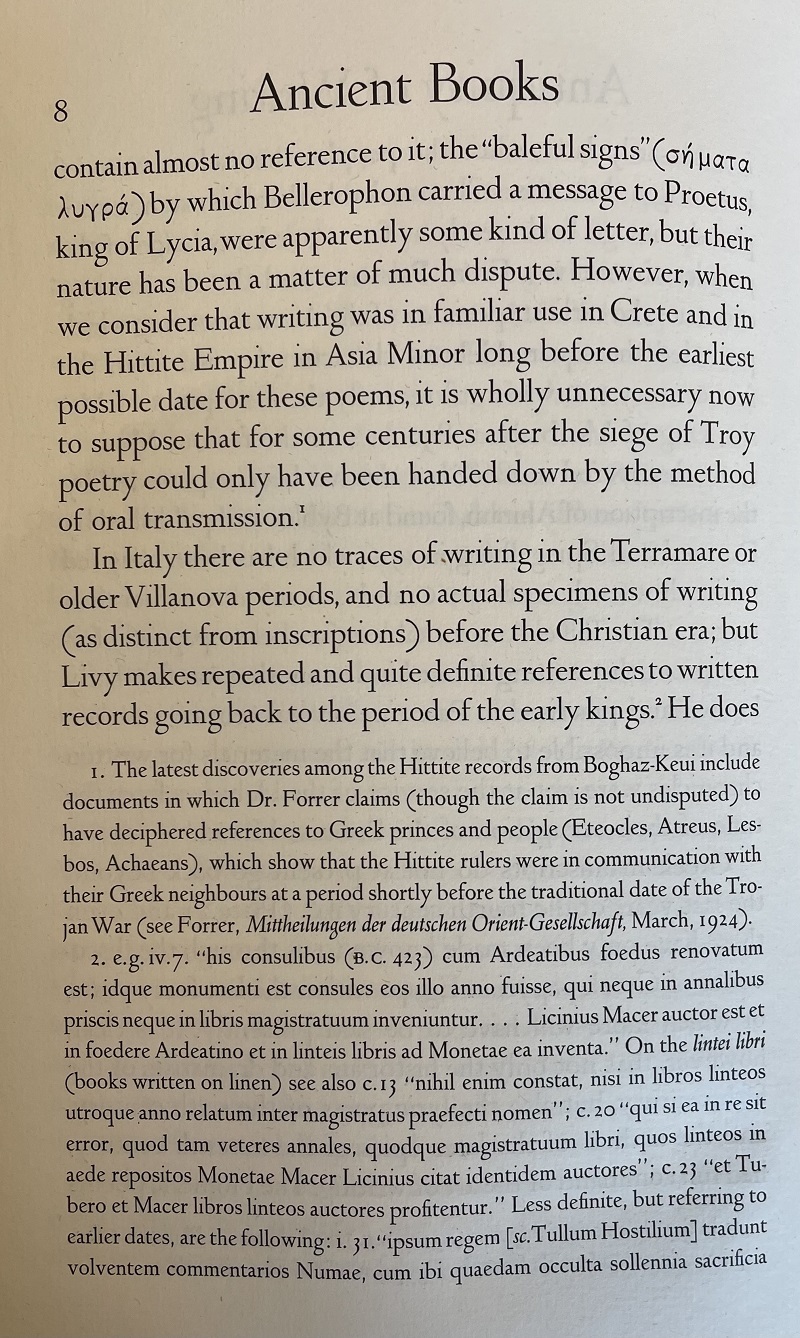
contain almost no reference to it; the “baleful signs” (Beezone: Greek keys not available) by which Bellerophon carried a message to Proetus, king of Lycia, were apparently some kind of letter, but their nature has been a matter of much dispute. However, when we consider that writing was in familiar use in Crete and in the Hittite Empire in Asia Minor long before the earliest possible date for these poems, it is wholly unnecessary now to suppose that for some centuries after the siege of Troy poetry could only have been handed down by the method of oral transmission.1
Italy there are no traces of writing in the Terramare or older Villanova periods, and no actual specimens of writing (as distinct from inscriptions) before the Christian era; but Livy makes repeated and quite definite references to written records going back to the period of the early kings.2 He does
- The latest discoveries among the Hittite records from Boghaz-Keui include documents in which Dr. Forrer claims (though the claim is not undisputed) to have deciphered references to Greek princes and people (Eteocles, Atreus, Lesbos, Achaeans), which show that the Hittite rulers were in communication with their Greek neighbours at a period shortly before the traditional date of the Troian War (see Forrer, Mittheilunen der deutschen Orient-Gesellschaft, March, 1924).
- e.g.iv.7. “his consuhbus (b.c. 42}) cum Ardeatibus foedus renovatum est; idque monumenti est consules eos illo anno fuisse, qui neque in annalibus priscis neque in libris magistratuum inveniuntur.. ,. Licinius Macer auctor est et in foedere Ardeatino et in hnteis libris ad Monetae ea inventa.” On the lintei libri (books written on linen) see also c.ij “nihil enim constat, nisi in libros linteos utroque anno relatum inter magistratus praefecti nomen’ ’; c. 20 ‘ ‘qui si ea in re sit error, quod tarn veteres annales, quodque magistratuum libri, quos linteos in aede repositos Monetae Macer Licinius citat identidem auctores”; c,2? “et Tu- bero et Macer libros hnteos auctores profitentur.” Less definite, but referring to earlier dates, are the following: i. p.“ipsum regem [^c.Tullum Hostilium] tradunt volventem commentarios Numae, cum ibi quaedam occulta sollennia sacrificia
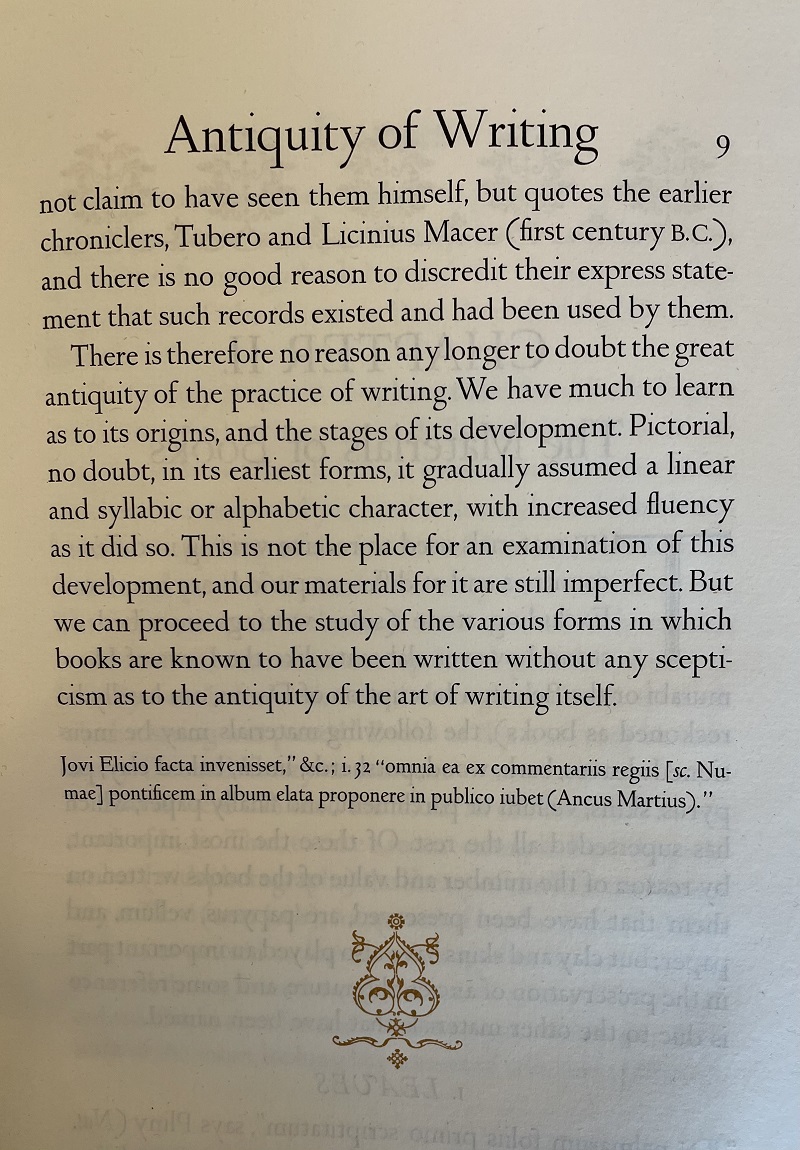
not claim to have seen them himself, but quotes the earlier chroniclers, Tubero and Licinius Macer (first century B.C.), and there is no good reason to discredit their express statement that such records existed and had been used by them. There is therefore no reason any longer to doubt the great antiquity of the practice of writing. We have much to learn as to its origins, and the stages of its development. Pictorial, no doubt, in its earliest forms, it gradually assumed a linear and syllabic or alphabetic character, with increased fluency as it did so. This is not the place for an examination of this development, and our materials for it are still imperfect. But we can proceed to the study of the various forms in which books are known to have been written without any scepticism as to the antiquity of the art of writing itself.
Jovi Elicio facta invenisset,” &c.; i. p “omnia ea ex commentariis regiis [sc. Nu- mae] pontificem in album elata proponere in publico iubet (Ancus Martius). ”
———————————-
During the First World War, Frederic Kenyon was a Major (temporary Lt. Col.) in the Territorial Force (Inns of Courts). He served with the British Expeditionary Force in France from August to September 1914 and with his regiment until 1919.
In November 1917, Kenyon was appointed as the Imperial War Graves Commission’s Artistic Adviser. He visited the battlefields of France and Belgium and compiled a report in which he submitted the chief governing principles for the architectural treatment and laying out of war cemeteries. The Commission adopted his recommendations in the practise of its constructional work. Kenyon was a strong supporter of the principle of equality of treatment and made constant visits to the Commission’s cemeteries as they were developed.
After 1928, Sir Frederic Kenyon remained Honorary Artistic Adviser until his retirement from the Commission in 1948, when was succeeded by Sir Edward Maufe.
He died on 23 August 1952, aged 89.
CHAPTER I.
The Antiquity of Writing
Editor’s Note:
The following chapter preserves Kenyon’s original text as first published in 1927. Modern annotations, inserted in brackets, highlight discoveries and refinements made since his time. These notes are intended to supplement, not replace, Kenyon’s scholarship—allowing his work to be read both as a classic statement of early 20th-century knowledge and as a foundation enriched by later research.
Kenyon:
The purpose of this essay is to give some picture, according to our present knowledge, of the various methods by which man has endeavored to commit his words,—the repositories of his experience or his thoughts—to permanent record by some form of writing. The perpetuation of the spoken word in enduring form is one of the most potent elements of civilisation…
[Modern Note]: This remains foundational. Later scholars (e.g., Jack Goody, Walter Ong) have emphasized that writing not only preserves but also reshapes thought and memory, fundamentally altering cultural and intellectual life.
Kenyon:
Until quite recently it was usual to maintain that writing was a relatively late accomplishment… the Homeric poems… the Pentateuch… could only have been handed down by oral tradition…
[Modern Note]: Discoveries now show writing was available much earlier. The Wadi el-Hol inscriptions in Egypt (~1900–1800 BCE) and the Canaanite ivory comb from Lachish (~1700 BCE) demonstrate alphabetic writing centuries before Kenyon’s timeline, though oral tradition certainly remained central.
Kenyon:
The Prisse Papyrus… Twelfth Dynasty… 2200–2000 B.C.
[Modern Note]: Still broadly accurate. But evidence of proto-writing extends further back: Jiahu symbols in China (~7000 BCE) and Vinča markings in southeastern Europe (~5500–4000 BCE), often seen as transitional stages between symbolic notation and true writing.
Kenyon:
Stone inscriptions of about 2900 B.C. at Nippur… most primitive writings at Kish… hardly later than 3500 B.C.
[Modern Note]: Now recognized that proto-cuneiform in Uruk (~3350–3000 BCE) predates these. Even earlier, Mesopotamian cylinder seals (~4400 BCE) are viewed as precursors, linking imagery to emerging script.
Kenyon:
At Boghaz-Keui… Hittite archives… In Crete, Sir Arthur Evans discovered tablets in linear scripts… still undeciphered…
[Modern Note]: Linear B was deciphered in 1952 (Michael Ventris), revealing an early form of Greek. Linear A remains undeciphered, though statistical and computational approaches continue.
Kenyon:
…the inscription of Ahiram at Byblos… earlier than 1000 B.C.
[Modern Note]: Earlier evidence has since been found. The Wadi el-Hol inscriptions (~1900 BCE) and the Lachish comb (~1700 BCE) push the alphabet’s origins back by over seven centuries.
Kenyon:
Greek manuscripts do not at present go back beyond the fourth century B.C.…
[Modern Note]: This has changed. The Derveni Papyrus (~340 BCE) is now the oldest surviving European “book.” Numerous papyri from Egypt, aided by multispectral imaging and AI dating methods, extend our reach beyond Kenyon’s horizon.
Kenyon:
Livy makes repeated and definite references to written records in the early kings…
[Modern Note]: Debate continues. While Kenyon saw no specimens before the Christian era, archaeology now confirms inscriptions in Italy by ~575 BCE (the Forum inscription). This shows Roman literacy earlier than once assumed.
Kenyon (conclusion):
There is therefore no reason any longer to doubt the great antiquity of the practice of writing…
[Modern Note]: Kenyon’s conclusion still stands strong: writing is ancient and central to civilization. Today, its origins are seen as multiple, gradual, and global, spanning Mesopotamia, Egypt, China, and Mesoamerica, each shaping cultural development in distinctive ways.
Further Reading: Modern Studies on the Antiquity of Writing
-
Goody, Jack. The Logic of Writing and the Organization of Society. Cambridge University Press, 1986.
– A classic study on how writing transforms social and intellectual structures. -
Ong, Walter J. Orality and Literacy: The Technologizing of the Word. Routledge, 1982.
– Explores the shift from oral to literate culture and its profound consequences. -
Coulmas, Florian. The Blackwell Encyclopedia of Writing Systems. Blackwell, 1996.
– A comprehensive reference on the world’s writing systems, ancient and modern. -
Houston, Stephen (ed.). The First Writing: Script Invention as History and Process. Cambridge University Press, 2004.
– Comparative perspectives on independent origins of writing in Mesopotamia, Egypt, China, and Mesoamerica. -
Cooper, Jerrold S. Sumerian and Akkadian Royal Inscriptions I: Presargonic Inscriptions. American Oriental Society, 1986.
– Primary sources illustrating early Mesopotamian writing traditions. -
Robinson, Andrew. Lost Languages: The Enigma of the World’s Undeciphered Scripts. McGraw-Hill, 2002.
– Accessible survey of scripts still not fully understood, such as Linear A and the Indus script. -
Schmandt-Besserat, Denise. How Writing Came About. University of Texas Press, 1996.
– Groundbreaking work on the role of clay tokens and counting systems as precursors to writing. -
Baines, John. “Origins of Egyptian Writing.” In The Disappearance of Writing Systems: Perspectives on Literacy and Communication, edited by John Baines, John Bennet, and Stephen Houston, Equinox, 2008.
– A focused discussion on how writing emerged in Egypt. -
Powell, Barry B. Writing: Theory and History of the Technology of Civilization. Wiley-Blackwell, 2009.
– Argues that the Greek alphabet was a deliberate invention to record Homeric epic. -
Christensen, Alex J. et al. “Rolling Back the Origins of Writing: Cylinder-Seal Imagery and Proto-Cuneiform.” Antiquity (2024).
– A recent study proposing that Mesopotamian seal imagery helped generate early cuneiform.
